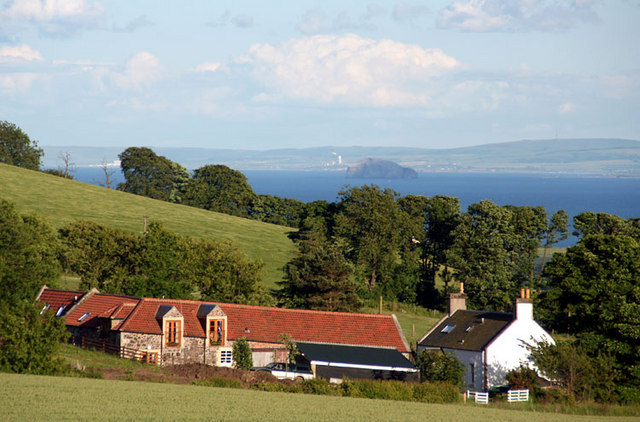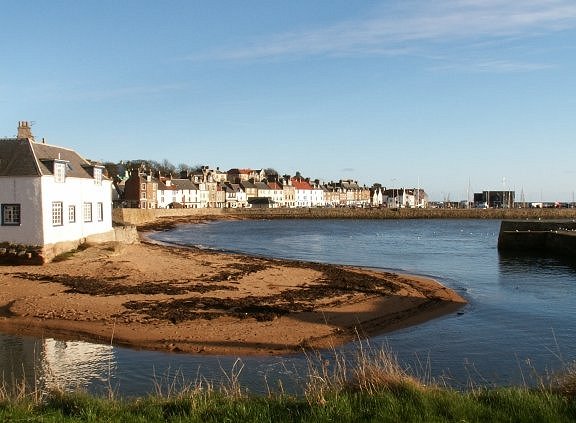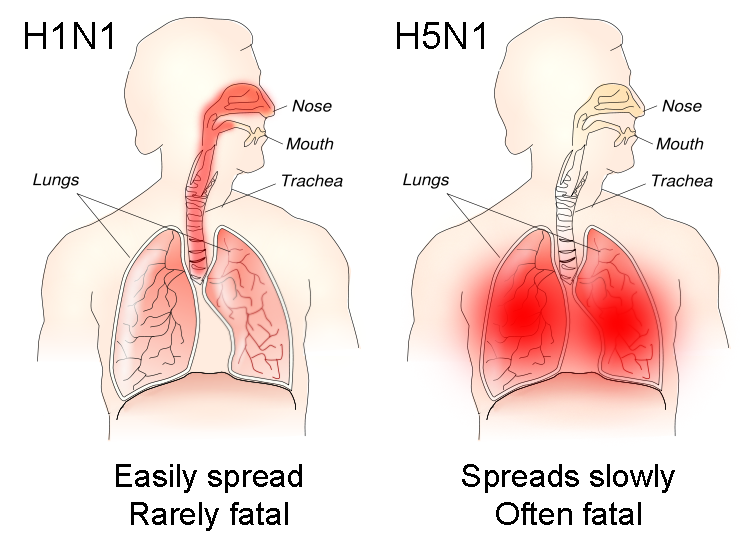|
Cellardyke
Cellardyke is a village in the East Neuk of Fife, Scotland. The village is to the immediate east of Anstruther (the two effectively being conjoined) and is to the south of Kilrenny. History Cellardyke was formerly known as Nether Kilrenny ( Scots for ''Lower Kilrenny'') or Sillerdyke, and the harbour as Skinfast Haven, a name which can still be found on maps today. The harbour was built in the 16th century and was rebuilt in 1829–31. The modern name of the town is thought to have evolved from Sillerdykes ( Eng: ''silverwalls''), a reference to the sun glinting off fish scales encrusted on fishing nets left to dry in the sun on the dykes around the harbour. Cellardyke and Kilrenny came together as the royal burgh of Kilrenny from 1592, having been a burgh of regality since 1578. Cellardyke remains officially part of Kilrenny parish, and also part of the Anstruther fishing district, its fortunes fluctuating with the fishing trade. The population grew quickly in the 19th cen ... [...More Info...] [...Related Items...] OR: [Wikipedia] [Google] [Baidu] |
Cellardyke Town Hall (geograph 6112610)
Cellardyke Town Hall is a municipal structure in Tolbooth Wynd, Cellardyke, Fife, Scotland. The building accommodates a local history museum and is also used as a local events venue. The mercat cross, which has been affixed to the front of the building, is a Category B listed structure. History The first municipal building in Cellardyke was a tolbooth which was completed in 1642. A new mercat cross was carved at that time and erected outside the building. The tolbooth was used as a prison as well as being a regular meeting place for Kilrenny Burgh Council. By the early 1880s, the tolbooth had become dilapidated and the burgh leaders decided to demolish the tolbooth and to erect a new building on the same site. The politician and shipping company founder, Stephen Williamson, and the Australian grocery wholesaler, David Fowler, each agreed to contribute £5,000 to the cost of the new building. The foundation stone for the new building was laid by the provost, Robert Watson, on ... [...More Info...] [...Related Items...] OR: [Wikipedia] [Google] [Baidu] |
Cellardyke Town Hall
Cellardyke Town Hall is a municipal structure in Tolbooth Wynd, Cellardyke, Fife, Scotland. The building accommodates a local history museum and is also used as a local events venue. The mercat cross, which has been affixed to the front of the building, is a Category B listed structure. History The first municipal building in Cellardyke was a tolbooth which was completed in 1642. A new mercat cross was carved at that time and erected outside the building. The tolbooth was used as a prison as well as being a regular meeting place for Kilrenny Burgh Council. By the early 1880s, the tolbooth had become dilapidated and the burgh leaders decided to demolish the tolbooth and to erect a new building on the same site. The politician and shipping company founder, Stephen Williamson, and the Australian grocery wholesaler, David Fowler, each agreed to contribute £5,000 to the cost of the new building. The foundation stone for the new building was laid by the provost, Robert Watson, on ... [...More Info...] [...Related Items...] OR: [Wikipedia] [Google] [Baidu] |
Fife
Fife (, ; gd, Fìobha, ; sco, Fife) is a council area, historic county, registration county and lieutenancy area of Scotland. It is situated between the Firth of Tay and the Firth of Forth, with inland boundaries with Perth and Kinross (i.e. the historic counties of Perthshire and Kinross-shire) and Clackmannanshire. By custom it is widely held to have been one of the major Pictish kingdoms, known as ''Fib'', and is still commonly known as the Kingdom of Fife within Scotland. A person from Fife is known as a ''Fifer''. In older documents the county was very occasionally known by the anglicisation Fifeshire. Fife is Scotland's third largest local authority area by population. It has a resident population of just under 367,000, over a third of whom live in the three principal towns, Dunfermline, Kirkcaldy and Glenrothes. The historic town of St Andrews is located on the northeast coast of Fife. It is well known for the University of St Andrews, the most ancient univers ... [...More Info...] [...Related Items...] OR: [Wikipedia] [Google] [Baidu] |
East Neuk
The East Neuk () or East Neuk of Fife is an area of the coast of Fife, Scotland. "Neuk" is the Scots word for nook or corner, and the East Neuk is generally accepted to comprise the fishing villages of the most northerly part of the Firth of Forth and the land and villages slightly inland therefrom. In effect, this means that part to the south of a line drawn parallel to the coast from just north of Earlsferry to just north of Crail, approximately in area. As such it would include Elie and Earlsferry, Colinsburgh, St Monans, Pittenweem, Arncroach, Carnbee, Anstruther, Cellardyke, Kilrenny, Crail and Kingsbarns and the immediate hinterland, as far as the upland area known as the Riggin o Fife. The area houses a Cold War era bunker near Crail. Built in the late 1950s to be a regional seat of government in the event of a nuclear war Nuclear warfare, also known as atomic warfare, is a theoretical military conflict or prepared political strategy that deploys nuclear wea ... [...More Info...] [...Related Items...] OR: [Wikipedia] [Google] [Baidu] |
Anstruther
Anstruther ( sco, Ainster or Enster ; gd, Ànsruthair) is a small coastal resort town in Fife, Scotland, situated on the north-shore of the Firth of Forth and south-southeast of St Andrews. The town comprises two settlements, Anstruther Easter and Anstruther Wester, which are divided by a stream, the Dreel Burn. With a population of 3,500, it is the largest community on the Firth of Forth's north-shore coastline known as the East Neuk. To the east, it merges with the village of Cellardyke. Description Founded as a fishing village, Anstruther is home to the Scottish Fisheries Museum. Recreational vessels are now moored in the harbour, and a golf course is situated near the town. Anstruther Pleasure Cruises operate sightseeing/wildlife cruises from the harbour to the Isle of May, the UK's primary puffin location, on board the vessel the ''May Princess'' from April to October. An abundance of other wildlife, including seal colonies, also inhabit the island. The Waid Academy ... [...More Info...] [...Related Items...] OR: [Wikipedia] [Google] [Baidu] |
Kilrenny
Kilrenny ( gd, Cill Reithnidh) is a village in Fife, Scotland. Part of the East Neuk, it lies immediately to the north of (but inland and separate from) Anstruther on the south Fife coast. The first element of the name is from the Scottish Gaelic ''cill'', meaning 'church'. The '-renny' element may perpetuate a worn down form of Etharnan or Itharnan, an early churchman who 'died among the Picts' in 669 according to the ''Annals of Ulster''." That Kilrenny is of early Christian origin is suggested both by the Kil- element of the place-name, and by the Skeith Stone, a carved stone with marigold motif (''circa'' 700?) which stands to the west of the village, possibly marking an ancient area of sanctity. The village was formerly Upper Kilrenny, until nearby Lower Kilrenny changed its name to Cellardyke in the 16th century. The oldest part of the present church is the 15th century tower, with the body of the building rebuilt in 1807–08 (re-using the original stones as building ... [...More Info...] [...Related Items...] OR: [Wikipedia] [Google] [Baidu] |
Firth Of Forth
The Firth of Forth () is the estuary, or firth, of several Scottish rivers including the River Forth. It meets the North Sea with Fife on the north coast and Lothian on the south. Name ''Firth'' is a cognate of ''fjord'', a Norse word meaning a narrow inlet. ''Forth'' stems from the name of the river; this is ''*Vo-rit-ia'' (slow running) in Proto-Celtic, yielding '' Foirthe'' in Old Gaelic and '' Gweryd'' in Welsh. It was known as ''Bodotria'' in Roman times. In the Norse sagas it was known as the ''Myrkvifiörd''. An early Welsh name is ''Merin Iodeo'', or the "Sea of Iudeu". Geography and economy Geologically, the Firth of Forth is a fjord, formed by the Forth Glacier in the last glacial period. The drainage basin for the Firth of Forth covers a wide geographic area including places as far from the shore as Ben Lomond, Cumbernauld, Harthill, Penicuik and the edges of Gleneagles Golf Course. Many towns line the shores, as well as the petrochemical complexes at Gr ... [...More Info...] [...Related Items...] OR: [Wikipedia] [Google] [Baidu] |
Avian Influenza
Avian influenza, known informally as avian flu or bird flu, is a variety of influenza caused by viruses adapted to birds.Chapter Two : Avian Influenza by Timm C. Harder and Ortrud Werner in ''Influenza Report 2006'' CDC has a phylogenetic tree showing the relationship between dozens of highly pathogenic varieties of the Z genotype of avian flu virus H5N1 and ancestral strains. The type with the greatest risk is highly pathogenic avian influenza (HPAI). Bird flu is s ... [...More Info...] [...Related Items...] OR: [Wikipedia] [Google] [Baidu] |
Harbour Entrance, Cellardyke, Fife
A harbor (American English), harbour (British English; see spelling differences), or haven is a sheltered body of water where ships, boats, and barges can be docked. The term ''harbor'' is often used interchangeably with ''port'', which is a man-made facility built for loading and unloading vessels and dropping off and picking up passengers. Ports usually include one or more harbors. Alexandria Port in Egypt is an example of a port with two harbors. Harbors may be natural or artificial. An artificial harbor can have deliberately constructed breakwaters, sea walls, or jettys or they can be constructed by dredging, which requires maintenance by further periodic dredging. An example of an artificial harbor is Long Beach Harbor, California, United States, which was an array of salt marshes and tidal flats too shallow for modern merchant ships before it was first dredged in the early 20th century. In contrast, a natural harbor is surrounded on several sides of land. Examples of n ... [...More Info...] [...Related Items...] OR: [Wikipedia] [Google] [Baidu] |
United Kingdom
The United Kingdom of Great Britain and Northern Ireland, commonly known as the United Kingdom (UK) or Britain, is a country in Europe, off the north-western coast of the continental mainland. It comprises England, Scotland, Wales and Northern Ireland. The United Kingdom includes the island of Great Britain, the north-eastern part of the island of Ireland, and many smaller islands within the British Isles. Northern Ireland shares a land border with the Republic of Ireland; otherwise, the United Kingdom is surrounded by the Atlantic Ocean, the North Sea, the English Channel, the Celtic Sea and the Irish Sea. The total area of the United Kingdom is , with an estimated 2020 population of more than 67 million people. The United Kingdom has evolved from a series of annexations, unions and separations of constituent countries over several hundred years. The Treaty of Union between the Kingdom of England (which included Wales, annexed in 1542) and the Kingdom of Scotland in 170 ... [...More Info...] [...Related Items...] OR: [Wikipedia] [Google] [Baidu] |
Swan
Swans are birds of the family (biology), family Anatidae within the genus ''Cygnus''. The swans' closest relatives include the goose, geese and ducks. Swans are grouped with the closely related geese in the subfamily Anserinae where they form the tribe (biology), tribe Cygnini. Sometimes, they are considered a distinct subfamily, Cygninae. There are six living and many extinct species of swan; in addition, there is a species known as the coscoroba swan which is no longer considered one of the true swans. Swans usually mate for life, although "divorce" sometimes occurs, particularly following nesting failure, and if a mate dies, the remaining swan will take up with another. The number of bird egg, eggs in each :wikt:clutch, clutch ranges from three to eight. Etymology and terminology The English word ''swan'', akin to the German language, German , Dutch language, Dutch and Swedish language, Swedish , is derived from Indo-European root ' ('to sound, to sing'). Young swans are kn ... [...More Info...] [...Related Items...] OR: [Wikipedia] [Google] [Baidu] |
H5N1
Influenza A virus subtype H5N1 (A/H5N1) is a subtype of the influenza A virus which can cause illness in humans and many other animal species. A bird-adapted strain of H5N1, called HPAI A(H5N1) for highly pathogenic avian influenza virus of type A of subtype H5N1, is the highly pathogenic causative agent of H5N1 flu, commonly known as avian influenza ("bird flu"). It is enzootic (maintained in the population) in many bird populations, especially in Southeast Asia. One strain of HPAI A(H5N1) is spreading globally after first appearing in Asia. It is epizootic (an epidemic in nonhumans) and panzootic (affecting animals of many species, especially over a wide area), killing tens of millions of birds and spurring the culling of hundreds of millions of others to stem its spread. Many references to "bird flu" and H5N1 in the popular media refer to this strain. This was reprinted in 2005: According to the World Health Organization (WHO) and the United Nations Food and Agriculture O ... [...More Info...] [...Related Items...] OR: [Wikipedia] [Google] [Baidu] |
.jpg)


.jpg)



